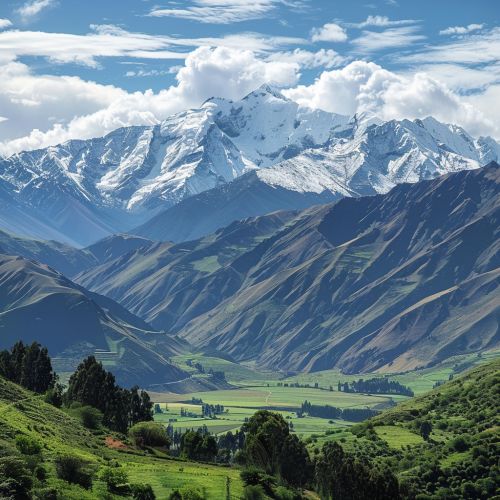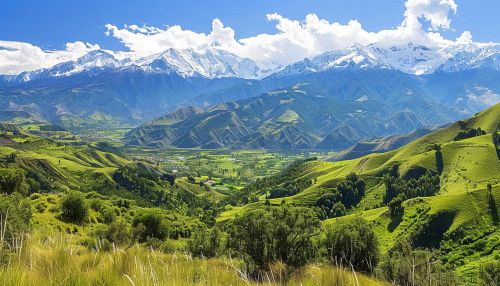South America: Difference between revisions
(Created page with "== Geography == South America is a continent located in the Western Hemisphere, primarily in the Southern Hemisphere, with a relatively small portion in the Northern Hemisphere. It is bordered on the west by the Pacific Ocean and on the north and east by the Atlantic Ocean; North America and the Caribbean Sea lie to the northwest. The continent is composed of 12 sovereign states: Argentina, Bolivia, Brazil, Chile, Colombia, Ecuador, Guyana, Paraguay, Peru, Suriname, Uru...") |
No edit summary |
||
| Line 3: | Line 3: | ||
South America is a continent located in the Western Hemisphere, primarily in the Southern Hemisphere, with a relatively small portion in the Northern Hemisphere. It is bordered on the west by the Pacific Ocean and on the north and east by the Atlantic Ocean; North America and the Caribbean Sea lie to the northwest. The continent is composed of 12 sovereign states: Argentina, Bolivia, Brazil, Chile, Colombia, Ecuador, Guyana, Paraguay, Peru, Suriname, Uruguay, and Venezuela, as well as the overseas department of French Guiana. | South America is a continent located in the Western Hemisphere, primarily in the Southern Hemisphere, with a relatively small portion in the Northern Hemisphere. It is bordered on the west by the Pacific Ocean and on the north and east by the Atlantic Ocean; North America and the Caribbean Sea lie to the northwest. The continent is composed of 12 sovereign states: Argentina, Bolivia, Brazil, Chile, Colombia, Ecuador, Guyana, Paraguay, Peru, Suriname, Uruguay, and Venezuela, as well as the overseas department of French Guiana. | ||
[[Image:Detail-91209.jpg|thumb|center|Panoramic view of the Andes mountains with snow-capped peaks and lush green valleys.|class=only_on_mobile]] | |||
[[Image:Detail-91210.jpg|thumb|center|Panoramic view of the Andes mountains with snow-capped peaks and lush green valleys.|class=only_on_desktop]] | |||
=== Andes Mountains === | === Andes Mountains === | ||
Latest revision as of 08:01, 22 June 2024
Geography
South America is a continent located in the Western Hemisphere, primarily in the Southern Hemisphere, with a relatively small portion in the Northern Hemisphere. It is bordered on the west by the Pacific Ocean and on the north and east by the Atlantic Ocean; North America and the Caribbean Sea lie to the northwest. The continent is composed of 12 sovereign states: Argentina, Bolivia, Brazil, Chile, Colombia, Ecuador, Guyana, Paraguay, Peru, Suriname, Uruguay, and Venezuela, as well as the overseas department of French Guiana.


Andes Mountains
The Andes Mountains, the longest continental mountain range in the world, run along the western edge of South America. They extend from the northernmost tip of the continent in Venezuela to the southern tip in Chile and Argentina. The range is known for its high peaks, including Aconcagua, the highest mountain outside Asia. The Andes are also home to diverse ecosystems and numerous glaciers, which are crucial for water supply in the region.
Amazon Basin
The Amazon Basin, encompassing the Amazon Rainforest, is the largest tropical rainforest in the world. It spans across several countries, with the majority located in Brazil. The Amazon River, the second-longest river in the world, flows through this basin. The region is known for its biodiversity, hosting millions of species of plants, animals, and insects. The rainforest plays a critical role in global carbon dioxide absorption and oxygen production.
Atacama Desert
The Atacama Desert, located in northern Chile, is one of the driest places on Earth. It stretches for about 1,000 kilometers along the coast of the Pacific Ocean. Despite its arid conditions, the desert is home to unique flora and fauna adapted to the harsh environment. The Atacama is also rich in mineral resources, particularly copper and lithium, making it an important area for mining activities.
History
Pre-Columbian Civilizations
Before the arrival of Europeans, South America was home to several advanced civilizations. The Inca Empire, based in modern-day Peru, was the largest empire in pre-Columbian America. It was known for its sophisticated agricultural practices, architectural achievements, and extensive road networks. Other notable civilizations included the Muisca in Colombia, the Tiahuanaco in Bolivia, and the Mapuche in Chile.
European Colonization
The colonization of South America began with the arrival of Christopher Columbus in 1492, followed by subsequent expeditions by Spanish and Portuguese explorers. The Treaty of Tordesillas in 1494 divided the continent between Spain and Portugal. Spanish conquistadors, such as Francisco Pizarro, conquered the Inca Empire, while Portuguese settlers established colonies in Brazil. The colonization process led to significant cultural and demographic changes, including the introduction of European languages, religions, and diseases.
Independence Movements
The 19th century saw a wave of independence movements across South America. Influenced by the American and French revolutions, leaders such as Simón Bolívar and José de San Martín led efforts to liberate the continent from Spanish and Portuguese rule. By the mid-1820s, most South American countries had gained independence, leading to the formation of new nations and the establishment of republican governments.
Economy
Natural Resources
South America is rich in natural resources, including minerals, oil, and agricultural products. The continent is a leading producer of copper, iron ore, and gold. Brazil is the largest producer of coffee and soybeans, while Argentina is known for its beef and wine production. The extraction and export of these resources play a crucial role in the economies of many South American countries.
Industrialization and Urbanization
The 20th century saw significant industrialization and urbanization in South America. Countries such as Brazil, Argentina, and Chile developed manufacturing sectors, producing goods ranging from automobiles to electronics. Urban centers like São Paulo, Buenos Aires, and Santiago grew rapidly, becoming major economic hubs. However, this growth also led to challenges such as income inequality, environmental degradation, and social unrest.
Trade and Integration
South American countries have sought to enhance economic integration through regional trade agreements. The Southern Common Market (MERCOSUR) is one of the most significant trade blocs, promoting free trade and economic cooperation among its member states. Other initiatives, such as the Andean Community and the Pacific Alliance, aim to strengthen economic ties and improve competitiveness in the global market.
Culture
Languages
The primary languages spoken in South America are Spanish and Portuguese, reflecting the continent's colonial history. Spanish is the official language in most countries, while Portuguese is spoken in Brazil. Indigenous languages, such as Quechua, Aymara, and Guarani, are also widely spoken, particularly in rural areas and among indigenous communities.
Religion
Roman Catholicism is the dominant religion in South America, a legacy of Spanish and Portuguese colonization. The continent is home to some of the largest Catholic populations in the world. Protestantism has also grown significantly in recent decades, particularly in Brazil and Chile. Indigenous religions and practices continue to be an important part of cultural identity for many communities.
Arts and Literature
South America has a rich tradition of arts and literature. The continent has produced renowned writers such as Gabriel García Márquez, Jorge Luis Borges, and Pablo Neruda. Latin American literature is known for its unique style, often referred to as magical realism, which blends fantastical elements with everyday reality. The visual arts, including painting, sculpture, and architecture, reflect the diverse cultural influences and historical experiences of the region.
Biodiversity
Flora
South America is home to an incredible diversity of plant species, many of which are found nowhere else on Earth. The Amazon Rainforest alone contains thousands of species of trees, including the Brazil nut tree and the rubber tree. The continent's varied climates and ecosystems, from tropical rainforests to high-altitude grasslands, support a wide range of vegetation.
Fauna
The fauna of South America is equally diverse, with numerous endemic species. The Amazon Basin is home to iconic animals such as jaguars, sloths, and anacondas. The Andes Mountains support species adapted to high altitudes, such as the Andean condor and the vicuña. The Galápagos Islands, located off the coast of Ecuador, are famous for their unique wildlife, including giant tortoises and marine iguanas, which played a crucial role in Charles Darwin's theory of evolution.
Conservation Efforts
Conservation efforts in South America aim to protect its rich biodiversity and address environmental challenges. Deforestation, driven by agriculture and logging, poses a significant threat to the Amazon Rainforest. Various national parks and protected areas have been established to preserve critical habitats. International organizations and local communities are also involved in initiatives to promote sustainable development and conservation.
Demographics
Population
South America has a population of approximately 430 million people. The continent is characterized by diverse ethnic groups, including indigenous peoples, descendants of European colonizers, African slaves, and immigrants from Asia and the Middle East. Urbanization is a prominent trend, with a significant portion of the population living in major cities such as São Paulo, Buenos Aires, and Lima.
Health and Education
Health and education systems vary widely across South America. Countries like Chile and Uruguay have relatively high standards of healthcare and education, while others face challenges in providing access to quality services. Efforts to improve public health and education are ongoing, with initiatives aimed at reducing disparities and increasing investment in these sectors.
Social Issues
South America faces various social issues, including poverty, inequality, and political instability. Economic disparities are evident, with significant differences in wealth and living standards between urban and rural areas. Social movements and protests are common, as citizens advocate for better governance, social justice, and human rights.
Political Landscape
Government Systems
South American countries have diverse political systems, ranging from presidential republics to federal states. Most nations have democratic governments, although the region has experienced periods of authoritarian rule and military dictatorships. Political stability varies, with some countries enjoying stable democratic institutions while others face ongoing political crises.
Regional Organizations
Regional organizations play a crucial role in promoting cooperation and addressing common challenges in South America. The Union of South American Nations (UNASUR) aims to foster political and economic integration, while the Organization of American States (OAS) works to promote democracy, human rights, and security across the Americas. These organizations provide platforms for dialogue and collaboration among member states.
International Relations
South American countries maintain diverse international relations, engaging with global powers and participating in international organizations. Brazil, as the largest and most populous country in the region, plays a significant role in global affairs. Trade agreements, diplomatic initiatives, and participation in international forums are key aspects of the continent's foreign policy.
